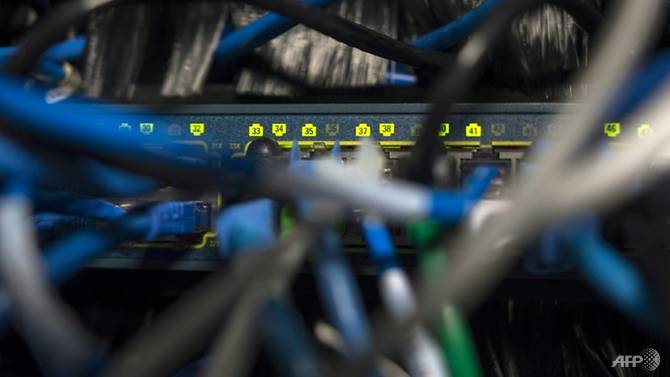COVID-19 happening in China doesn’t mean it originated in China
BEIJING: China on Thursday marked a major milestone in its battle against the coronavirus pandemic as it recorded zero domestic infections for the first time since the outbreak emerged, but a spike in imported cases threatened its progress.
The stark reversal comes as nations across the world have shut down in a desperate effort to contain the pandemic, with more people now infected and having died abroad than in China.
There were no new cases in Wuhan, the central city where the virus first emerged in December for the first time since authorities started publishing figures in January, according to the National Health Commission.
Wuhan and its 11 million people were placed under strict quarantine on Jan 23, with more than 40 million other people in the rest of Hubei province entering lockdown in the following days.
The rest of China also enacted tough measures to limit public gatherings.
There were eight more deaths in China all in Hubei raising the nationwide total to 3,245, according to the commission.
There have been nearly 81,000 infections in China but only 7,263 people remain sick with the Covid-19 disease.
The global number has shot past 200,000, with more than 8,700 deaths.
On March 10, President Xi Jinping visited Wuhan for the first time since the outbreak began and declared that the spread of the disease was “basically curbed”.
On the same day, Hubei officials allowed people to travel within the province for the first time since January, excluding Wuhan.
On Wednesday, Hubei authorities announced they were partially opening its borders to allow healthy people from low-risk areas to leave the province if they have jobs or residences elsewhere. This also excludes Wuhan.
Life has slowly started to return to normal in the rest of the country, with people back at work, factories up and running, and schools in some regions resuming or preparing to go back to class.
Second wave
But there is concern about a second wave of infections due to an influx of cases from abroad, with an average of 20,000 people flying into China every day.
Beijing and other regions are now requiring most international arrivals to go into 14-day quarantine in designated hotels.
The National Health Commission said there were 34 more cases brought in from abroad, the biggest daily increase in two weeks, with 189 in total now.
“We should never allow the hard-won and continuous positive trend to be reversed,“ Xi said at a Communist Party leadership meeting on Wednesday.
The disease is believed to have jumped from an animal to humans at a market that illegally sold wild game in Wuhan late last year.
There have also been questions about China’s official figures, as authorities changed its methodology to count infections, and the government has endured rare public criticism of its handling of the health emergency.
Local officials initially attempted to cover up the outbreak, with police silencing doctors who had raised the alarm about the emergence of the new virus as early as December.
One of the whistleblowers, Wuhan ophthalmologist Li Wenliang, died from the virus himself in February, sparking an outpouring of grief and anger on social media.
The first case emerged in Wuhan on Dec 1, according to Chinese researchers, but it was not until Jan 9 the country confirmed a “new type of coronavirus”.
Between Jan 5 and 17, China reported no new cases of the virus, even as Japan and Thailand declared first infections a period that coincided with annual political meetings in Wuhan and Hubei province. – AFP
Trump’s ‘Chinese Virus’ backfires!
US President Donald Trump has referred to the novel coronavirus as “Chinese virus” at least eight times in tweets and media briefings within just two days, fueling widespread xenophobia and racist sentiment and even physical and verbal attacks against Asian Americans and undermining global efforts to contain the deadly virus.Trump’s comment, which is completely against science and facts, could also further promote already-growing populism and racism around the world amid the global pandemic that could plunge countries and regions that have been hit severely by the disease into further disarray and dark abyss, observers warned.
After tweeting several times “Chinese virus” to shift the blame to China, Trump insisted on calling it a “Chinese virus” because “it comes from China,” in response to a question from an American journalist on Wednesday. Growing numbers of Asian Americans have been frustrated by the labels of “Chinese virus” or “kung flu,” which risk turning them into a target of hatred and retaliation as the pandemic unfolds quickly in the country.
Trump started to use the term “Chinese virus” on Monday in six of his tweets, despite Vice President Mike Pence, head of the country’s coronavirus task force, still called it “coronavirus” on Wednesday. Trump stressed it is a Chinese virus twice in his opening remarks at a White House meeting on Tuesday and Wednesday. The White House even backed it up by tweeting that the “Spanish Flu, West Nile Virus, Zika and Ebola were named after places.”
The coronavirus pandemic has so far claimed 220,000 infections worldwide,
Apart from Trump, other US officials, including Secretary of State Mike Pompeo, GOP lawmakers Tom Cotton, Paul Gosar and Minority Leader Kevin McCarthy have been using terms like Wuhan virus and Chinese virus in public, intentionally stigmatizing China and Wuhan.
Downplaying his racist rhetoric, Trump argued he wanted to be accurate as he believed the virus comes from China, totally ignoring the impact on the Asian community, according to observers, local residents and some influencers.

Photo: GT
Offensive and immoral
On Wednesday, Trump dubbed the coronavirus “Chinese virus” three times in an hour, according to media reports, which seriously infuriated not only Chinese people but also many Asian Americans. Given the rising crimes against Asian and Chinese communities, some urged Trump to resign as such blunt incitement of racism is so dangerous that it could tear the world apart.
Some even shared their personal stories on social media about being insulted or attacked because of their skin color, ethnic group or nationality since the outbreak, and some said they don’t feel safe and feel severely offended, because racist terms encourage xenophobia and discrimination, which could last longer than the pandemic itself.
Jordan Matsudaira, an Asian-looking professor in New York, said his “children are being called ‘coronavirus’ in school, and this is racist, vile and intentional,” in a tweet.
And Cenk Uygur, a Los Angeles-based online news show host, said as his wife is from Taiwan that his children’s classmates are already blaming them “for the virus” and some ask them if they eat bats, because of “racists and a**holes like Senator John Cornyn and Trump.”
A New York-based Chinese woman, who preferred not to be named, shared an anecdote with the Global Times on Thursday that when she drove and waited at a traffic light one day, an American originally from Mexico spat at her car window, shouting, “F**king virus Chinese,” which “made her really sick,” she said.
The Atlantic Council’s Digital Forensic Research Lab (DFRLab) said in a recent article that continuing calling COVID-19 Chinese virus could be used to denigrate a group and implicitly blame Chinese people for the outbreak, despite the World Health Organization’s stepped up efforts to push back against stigmatizing terms that needlessly divide COVID-19 rhetoric.
The WHO came up in 2015 with guidelines on naming diseases, claiming that geographic locations, people’s names, animal species or food, cultural, population, industry or occupational references and those inciting undue fear should be avoided in disease names, after the organization saw certain disease names provoke a backlash against members of particular religious or ethnic communities, according to its website.
Some American scientists and medical experts also showed their support for WHO’s naming of COVID-19, emphasizing that it should not spark any political debates.
Some prominent figures in Chinese science circles also joined in to fight the ‘Chinese virus’ slander. Rao Yi, president of Capital Medical University in Beijing, said in a WeChat article on Wednesday that according to the US government’s logic, the first AIDS case was reported in the US on June 5, 1981, so should AIDS be called an American venereal disease and HIV the “American venereal virus?”
And should the spirochete leading to syphilis, which is widely considered to have originated in North America and transmitted to Europe by the Spanish, be called “North American spirochete?” he asked.
“Those officials who called it ‘Chinese virus’ are among those who have the lowest moral standards,” Lü Xiang, a research fellow on US studies at the Chinese Academy of Social Sciences in Beijing, told the Global Times on Thursday.
Take at look at what US Secretary of Commerce Wilbur Ross on January 30 said about the deadly virus, that it would help accelerate the return of jobs to the US. That claim reflected their true intention and deeply-rooted wishes that the virus could only spread in China, from which they could take advantage of, Lü said.
However, observers warned that rising hatred toward certain ethnic groups, entangled in the rise of right-wing populism amid the outbreak, would accelerate divisions and confrontations across the globe, which would also be dangerous and harmful following racial animosity and deaths from despair amid the outbreak.
Shift the blame
Eduardo Bolsonaro, Brazilian congressman, said in a tweet that what’s happening now is HBO’s TV series “Chernobyl,” blaming China for the coronavirus outbreak, reflecting some countries’ relentless efforts to pass the buck to Beijing and hide their own incompetence in curbing the virus spread across local communities, analysts said.
On Wednesday, a Danish education studio was revealed to have published an insulting song to introduce the novel coronavirus to children that contained lyrics like, “I am a new virus, I come from China,” triggering a backlash on Chinese social media. The incident happened about two months after a major Danish newspaper published a cartoon with the five stars on China’s national flag replaced by five coronavirus images.
“It’s inevitable that populism would be prevalent in the future, and it has become a common practice that specific groups would be targeted by hostility and hatred, which would have severe consequences,” Zhang Yiwu, a cultural professor at Peking University, told the Global Times.
Still, some US politicians, including Democrats like Joe Biden, have publicly criticized such inflammatory coronavirus rhetoric, and Biden was quoted as saying in media reports that “labeling COVID-19 a foreign virus does not displace the accountability for the misjudgments that have taken place so far by the Trump administration.”
“This is also a tactic that these US politicians use to redirect public attention by shifting suspicions over their incompetence to hatred toward China, but it won’t work, and the collapse on Wall Street proves it,” Lü said.
Read more:
No new Covid-19 cases in Hubei | The Star Online
Trump puts Asian Americans at risk with racist claim
Trump should stop his blame game and focus on epidemic prevention, because finding scapegoats cannot cover up the fact that he has not responded properly to the epidemic.
China turns corner as West slips up; reports zero Covid-19 …
China to firmly support its media to safeguard reputation, interests: Chinese FM
China supports its media in safeguarding their reputation and interests, the Chinese Foreign Ministry said on Thursday, adding that China is forced to take relevant countermeasures against American media reporters in China, based on the principle of reciprocity.
Why Wuhan is significant to China’s high-tech industry
Related posts:
https://youtu.be/uR_LfkGwBG8 As readers will recall from the earlier article (above), Japanese and Taiwanese epidemiologists and pharma..
https://youtu.be/-wA2aMdCGZM New coronavirus carriers found in Italy According to the latest reports from the Italian media, the









































































